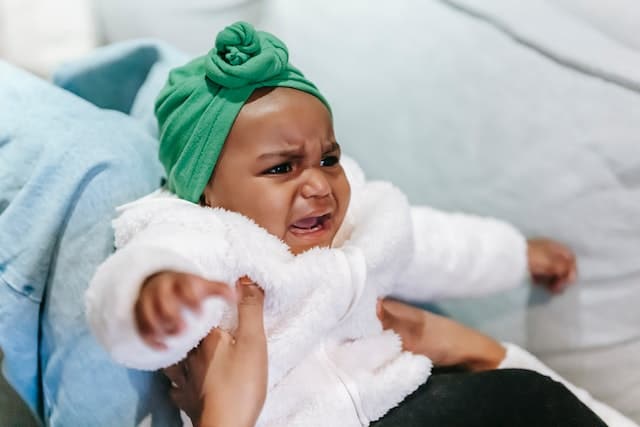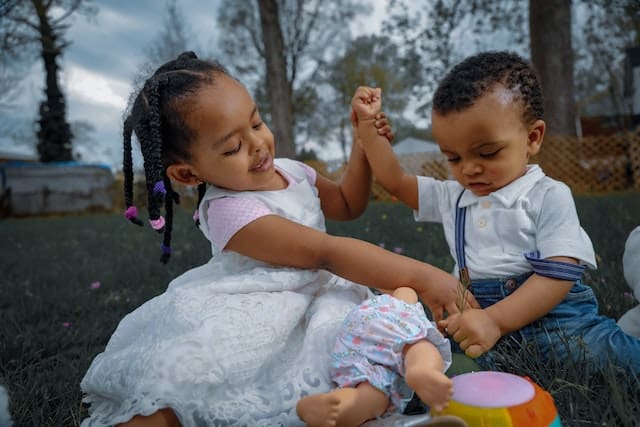Babies are known for their adorable and often unpredictable movements, including arm flapping. While some parents may find this behavior concerning, it is actually quite common and can be a normal part of development.
Understanding why babies flap their arms can help parents feel more at ease and provide appropriate support for their child’s growth.
Arm flapping is a common behavior in babies, typically starting around two to three months of age. This movement involves the baby extending their arms and then bringing them back in towards their body, often repeating the motion several times in a row.
While it may look unusual to adults, arm flapping can be a way for babies to explore their bodies and learn about cause and effect.
As parents observe their baby’s arm flapping, it is important to remember that this behavior can have many different meanings. While it can be a normal part of development, it can also be a sign of sensory processing issues or a developmental disorder like autism.
By understanding the different reasons why babies may flap their arms, parents can better support their child’s growth and development.
Key Takeaways
- Arm flapping is a common behavior in babies and can be a normal part of development.
- Arm flapping can be a way for babies to explore their bodies and learn about cause and effect.
- While arm flapping can be a normal behavior, it can also be a sign of sensory processing issues or a developmental disorder like autism.
Understanding Babies’ Arm Flapping
Babies are known for their adorable and sometimes puzzling behaviors. One behavior that parents often notice is arm flapping. This behavior can be seen in babies as young as a few months old and can continue until they are toddlers. But why do babies flap their arms?
Arm flapping is a physical expression that can have different meanings depending on the context. In some cases, babies may flap their arms when they are excited or happy. This behavior can be seen when a baby sees a favorite toy or a familiar face.
In other cases, arm flapping can be a sign of distress or frustration. Babies may flap their arms when they are hungry, tired, or uncomfortable.
Arm flapping can also be a part of a baby’s motor development. As babies grow and develop, they learn how to control their movements. Arm flapping can be a way for babies to practice and strengthen their arm muscles.
This behavior can also help babies learn about cause and effect. For example, a baby may flap his arms and notice that it makes a sound or moves a toy.
It is important to note that arm flapping can also be a sign of a developmental issue. In some cases, babies who flap their arms excessively may have a condition such as autism or sensory processing disorder. If parents are concerned about their baby’s arm flapping, they should talk to their pediatrician.
In conclusion, arm flapping is a common behavior in babies that can have different meanings depending on the context. While it can be a sign of excitement or frustration, it can also be a part of a baby’s motor development. If parents have concerns about their baby’s arm flapping, they should talk to their pediatrician.
Arm Flapping as a Normal Part of Development
Arm flapping is a common behavior that babies exhibit during their early months of life. This behavior is characterized by the baby flapping their arms up and down, often in a repetitive motion.
While arm flapping may seem unusual or concerning to some parents, it is actually a normal part of a baby’s development.
During the first few months of life, babies are learning to control their motor skills and coordinate their movements. Arm flapping is one way that babies explore their own bodies and the world around them.
By flapping their arms, babies are able to explore the range of motion in their arms and hands, and develop their hand-eye coordination.
Arm flapping can also be a form of self-stimulation for babies. As babies explore their environment, they may become overwhelmed or overstimulated by their surroundings. Arm flapping can help babies regulate their sensory input and calm themselves down.
While arm flapping is a normal behavior for babies, it is important to note that excessive arm flapping or arm flapping that is accompanied by other unusual behaviors may be a sign of a developmental disorder.
If you have concerns about your baby’s arm flapping or other behaviors, it is important to speak with your pediatrician.
Overall, arm flapping is a normal part of a baby’s development and an important way that babies learn to explore and interact with the world around them.
Emotional Expression and Arm Flapping
Babies are known for their arm flapping, which is often seen as a sign of excitement or joy. However, arm flapping can also be a form of emotional expression that is used to convey a range of feelings, including anxiety, stress, and the need for self-soothing.
When a baby is excited or happy, they may flap their arms as a way to express their joy and enthusiasm. This is often accompanied by other signs of excitement, such as smiling, laughing, and kicking their legs.
In these cases, arm flapping is a natural and healthy form of emotional expression that helps babies communicate their feelings to those around them.
On the other hand, arm flapping can also be a sign of anxiety or stress. When a baby is feeling overwhelmed or uncomfortable, they may flap their arms as a way to release tension and cope with their emotions. This can be especially common in babies who are sensitive to noise, light, or other environmental stimuli.
Finally, arm flapping can also be a form of self-soothing that babies use to calm themselves down when they are feeling upset or distressed. This is often seen in babies who have trouble falling asleep or who are experiencing separation anxiety.
Overall, arm flapping is a natural and normal part of a baby’s emotional expression. While it can be a sign of excitement and joy, it can also be a sign of anxiety or stress.
By understanding the different reasons why babies flap their arms, parents and caregivers can better support their emotional needs and help them develop healthy coping mechanisms.
See more in a related post: Why Do Babies Scratch Their Faces?
The Role of Sensory Input in Arm Flapping
Arm flapping is a common behavior seen in babies, especially during the first few months of life. While it may look unusual and even concerning to some parents, arm flapping is a normal part of development and can serve an important role in a baby’s sensory processing.
Sensory input plays a crucial role in arm flapping behavior. Babies are constantly taking in information from their environment through their senses, including touch, sight, sound, taste, and smell. Arm flapping can be a way for babies to explore and respond to the sensory input they receive.
For example, a baby may flap their arms in response to a sudden loud noise, such as a door slamming or a dog barking. This can be a way for the baby to release some of the energy and tension that builds up in response to the noise.
Similarly, a baby may flap their arms when they see something new or interesting, such as a colorful toy or a moving object. This can be a way for the baby to express excitement and curiosity.
In some cases, arm flapping may be a sign of a sensory processing disorder. Babies with sensory processing disorders may have difficulty processing and responding to sensory input in a typical way.
They may be overstimulated by certain types of sensory input, such as loud noises or bright lights, and seek out calming sensory experiences, such as arm flapping or rocking.
Overall, arm flapping is a normal and healthy behavior in babies that serves an important role in sensory processing. While it can be a sign of a sensory processing disorder in some cases, it is important for parents to trust their instincts and seek out support from a qualified healthcare provider if they have concerns about their baby’s development.
Arm Flapping as a Form of Communication
Arm flapping is a common behavior observed in babies and young children. While it may seem like a random and meaningless movement, research has shown that it can be a form of communication.
Babies who flap their arms may be trying to express excitement or joy. This is often seen when a baby is playing with a toy or interacting with a caregiver. Arm flapping may also be a way for babies to release excess energy or tension.
In some cases, arm flapping can be a sign of sensory overload. Babies who are overwhelmed by their environment may flap their arms as a way to self-soothe and regulate their sensory input.
This is particularly common in babies with autism or sensory processing disorders.
Arm flapping can also be a way for babies to communicate their needs or desires. For example, a baby may flap their arms when they want to be picked up or when they are hungry.
Caregivers can learn to interpret their baby’s arm flapping as a way of understanding their needs and responding appropriately.
Overall, arm flapping is a natural behavior that can serve a variety of functions in a baby’s development. By understanding the different reasons why babies flap their arms, caregivers can better support their child’s social and emotional development.
Autism Spectrum Disorder and Arm Flapping
Arm flapping is a common self-stimulatory behavior seen in children with Autism Spectrum Disorder (ASD). Self-stimulatory behaviors are repetitive behaviors that are often used by individuals with ASD to calm themselves or to cope with sensory overload.
Arm flapping is a type of self-stimulatory behavior that involves rapidly moving the arms up and down, often while standing or sitting.
Arm flapping is not unique to individuals with ASD, but it is more commonly observed in this population. Some studies suggest that up to 20% of children with ASD engage in arm flapping. While arm flapping is not harmful in and of itself, it can be a sign of underlying developmental disabilities.
Arm flapping is just one of many repetitive behaviors that are commonly associated with ASD. Other self-stimulatory behaviors include rocking, spinning, and hand flapping.
These behaviors are thought to be a way for individuals with ASD to regulate their sensory input and to cope with the overwhelming stimuli that they experience in their environment.
While arm flapping is not a definitive sign of ASD, it is often used as a diagnostic criterion for the disorder. Other signs of ASD include delayed speech and language development, difficulty with social interactions, and repetitive behaviors.
In conclusion, arm flapping is a common self-stimulatory behavior seen in individuals with ASD. While it is not harmful in and of itself, it can be a sign of underlying developmental disabilities. It is important for parents and caregivers to be aware of the signs of ASD and to seek early intervention if they suspect that their child may be affected.
When to Consult a Pediatrician
While arm flapping is usually a harmless behavior in babies, there are times when it may be a cause for concern. If a baby is flapping their arms excessively or in a way that seems unusual, it may be a sign of a developmental or neurological issue.
If a parent or caregiver notices any of the following symptoms in a baby who is arm flapping, they should consult a pediatrician:
- The baby is having difficulty with other motor skills, such as crawling or sitting up.
- The baby is not making eye contact or responding to social cues.
- The baby is not babbling or making other vocalizations.
- The baby is not reaching for or grasping objects.
- The baby is showing other signs of delayed development.
A pediatrician or other healthcare professional can evaluate the baby and determine if there is a cause for concern. They may recommend further evaluation or refer the baby to a specialist for further testing.
It is important for parents and caregivers to trust their instincts and seek medical attention if they have concerns about a baby’s arm flapping or any other behavior. Early intervention and treatment can make a big difference in a child’s development and overall health.
Understanding Treatment Plans
When a baby is diagnosed with a condition that causes arm flapping, a treatment plan is often developed to help manage the symptoms. Treatment plans can vary depending on the specific condition and severity of symptoms, but they generally involve a combination of therapies and interventions.
Caregivers play a crucial role in implementing treatment plans for their babies. They work closely with healthcare professionals to ensure that the plan is being followed correctly and to monitor progress. It is important for caregivers to be knowledgeable about the treatment plan and to ask any questions they may have.
Parenting techniques can also play a role in managing arm flapping in babies. For example, providing a calm and relaxing environment can help reduce stress and anxiety, which can exacerbate symptoms. Caregivers may also be advised to use techniques such as swaddling or massage to help soothe their baby.
Relaxation techniques can also be incorporated into a treatment plan to help manage symptoms. For example, deep breathing exercises or meditation can help reduce stress and anxiety, which can in turn reduce the frequency and intensity of arm flapping.
Overall, treatment plans for babies with arm flapping can be complex and require a multidisciplinary approach. Caregivers, healthcare professionals, and parenting techniques all play a role in managing symptoms and improving outcomes.
Frequently Asked Questions
What are some reasons why babies flail their arms?
Babies may flail their arms as a normal part of their development. This can occur when they are excited or trying to communicate something. Arm flapping can also be a sign of discomfort or frustration, such as when a baby is hungry or tired.
How can I help my baby stop flapping their arms?
It is important to first understand why your baby is flapping their arms. If it is a normal part of their development, there may not be a need to stop it. However, if it is causing discomfort or frustration, you can try to distract your baby with toys or other activities. Providing a calm and soothing environment can also help.
Is it normal for babies to raise their arms above their head?
Yes, it is normal for babies to raise their arms above their head. This can occur when they are excited, trying to communicate, or simply exploring their body movements.
What are some signs that my baby’s arm flapping may be a concern?
If your baby’s arm flapping is excessive or accompanied by other concerning symptoms, such as delayed speech or lack of eye contact, it may be a sign of a developmental issue. It is important to discuss any concerns with your pediatrician.
Can arm flapping be a sign of autism in babies?
Arm flapping can be a sign of autism in babies, but it is not always a definitive indicator. Other symptoms, such as delayed speech and lack of social interaction, are typically present as well. If you have concerns about your baby’s development, it is important to discuss them with your pediatrician.
How can I tell if my baby’s arm flapping is a developmental milestone or a problem?
If your baby’s arm flapping is a normal part of their development, it will likely occur in conjunction with other milestones, such as rolling over and crawling. If it is excessive or accompanied by other concerning symptoms, it may be a sign of a problem. It is important to discuss any concerns with your pediatrician.
Related Post: How to Get Boogers out of Newborn Nose?

Iesha is a loving mother of 2 beautiful children. She’s an active parent who enjoys indoor and outdoor adventures with her family. Her mission is to share practical and realistic parenting advice to help the parenting community becoming stronger.



